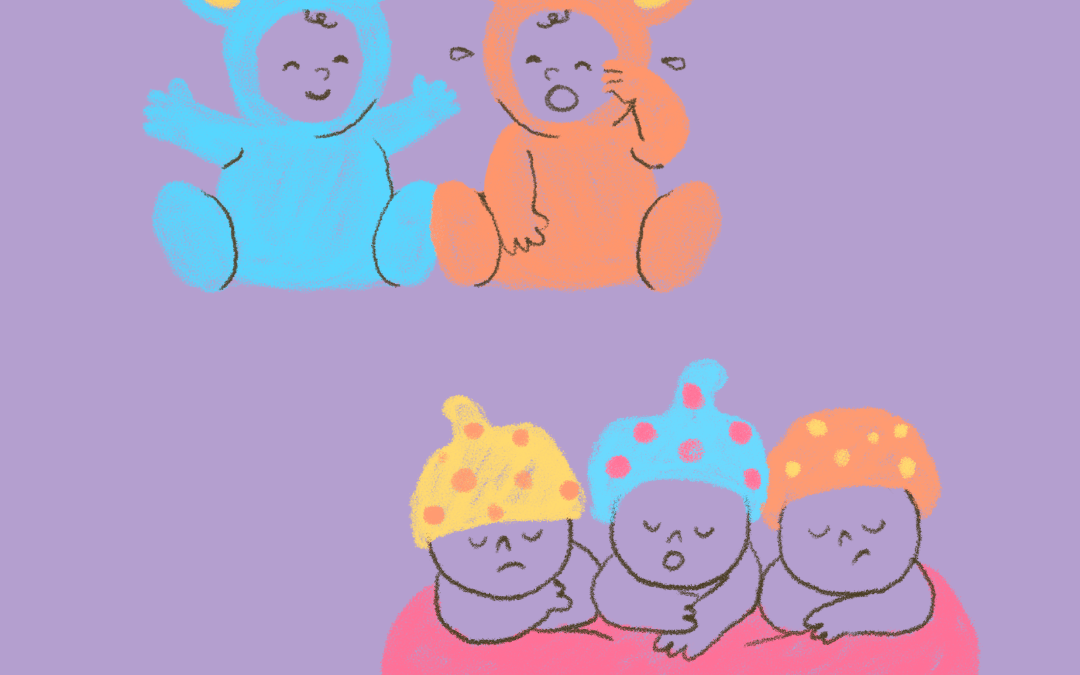It can be very exciting and slightly intimidating if you are expecting multiple babies at once. Big congratulations and we hope everything is going well. Things will be slightly different to a pregnancy with a single baby. Some of this may be expected, some might not.
In this blog, we want to give you a few little bits of info on what to expect when you are expecting multiple babies. If you are curious, read on.
1. There are different types of Twins
Ok so yes you may know this already, but it is interesting, nonetheless.
Identical Twins
Up first… Identical twins. Also medically known as monozygotic twins, these babies are from the same singular egg. This egg then separates into two embryos with identical genetic material creating two identical babies. Thus they are born the same sex, with the same hair and eye colour and generally looking very very similar. However, in the womb and as they grow up environmental factors may cause differences in appearance, but they are otherwise the same.
Interestingly identical twins can share a placenta or have two separate ones. About 1 third of identical twins have separate placentas. If the single egg splits right away and the halves implant quickly, they will have two placentas. If the split is delayed then they will share the one.
Fraternal Twins
The next type is non-identical, dizygotic, or fraternal twins. As the name suggests they are different. Non-identical twins are formed from two eggs fertilized by two separate sperm. They are about as genetically similar as siblings sharing about 50% of their chromosomes. This is why they can be of different sexes and can look very different with different eye and hair colours.
Fraternal twins rarely share a placenta. Typically, they will have two separate placentas as they will implant in the uterus separately.
A third type?
This isn’t fully confirmed but there could be a third type of twin called Polar Twins. Research conducted in 2016 suggested that some fraternal twins look so similar due to them coming from the same egg that split in half and was then fertilized by two separate sperm.
Unique Twin Types
We won’t go into much detail about the more unique rare types of twins but here is a quick list…
– Mirror twins
– Conjoined twins
– Parasitic twins
– Semi-identical twins
– Female and male identical twins
As for fraternal twins, there can …
– Twins of different ages
– Twins with different fathers
– Twins with different skin colours
Triplets or more
Just as an additional piece of information in this section, additional multiples can be identical, fraternal or a combination of both.
2. Expect extra medical care
Being pregnant with multiply comes with some extra health risks so expect some extra medical care as your pregnancy progresses.
Your healthcare provider will be tracking your babies’ growth, development and health and checking for signs of things like early labour. You could need more ultrasounds and other tests. Expect to be booking a few extra antenatal appointments.
3. Be ready for some new clothes
Carrying extra little ones will mean your baby bump will show sooner and be bigger than the bump of a single baby. It will also be bigger to accommodate the little ones.
For twins, you can be the size of a full-grown single baby by the time you are 32 weeks (imagine it for triplets) so be prepared to get lots of comfy baggy clothing ready!
4. Statistics
If you have ever wondered what your chances of having twins are here are some stats for you…
In the UK the chances of having identical twins are about 1 in 250. For non-identical twins, the chances are slightly higher.
Interestingly women who have a family history of them have a higher chance of producing non-identical twins but in general twins don’t run in the family. You can’t predict twins based on your genetics.
For triplets, the chances of them occurring naturally is 1 in 10,000 and for quadruplets is 1 in 700,00.
If you are trying to conceive via IVF there are some other stats to consider. The rate of twins is 12.1% for women under 35, 9.1% for women 35-37, 5.3% for women 38-40 and for those above 40, the rate is just 0.5%.
Storing Cord Blood for Twins
You can 100% still store cord blood for your twins! For further details, you can check out our blog about it here. But as a quick summary no matter if they are monozygotic or dizygotic twins you can store them. We recommend you store for both twins, especially if they are non-identical. Same for other multiples, best to save for all of them.
On top of that, it will not be twice or three times as much either. We offer a 50% discount for subsequent children in the same pregnancy. If you want to find out more you can get your FREE parent guide below or get in contact via email at enquiry@cells4life.com or call 01444 873950.
Request a Welcome Pack
Find out more about cord blood banking by downloading a Welcome Pack now.








